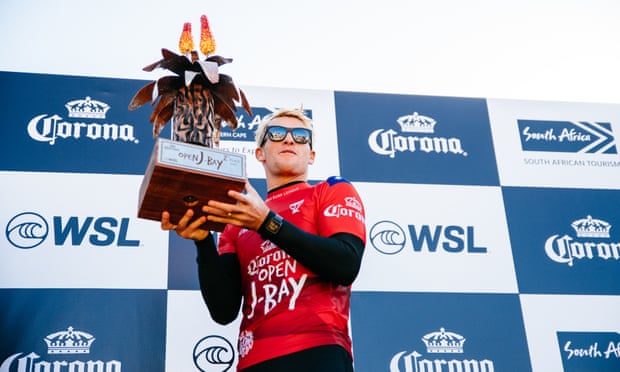Against a backdrop of successive eras of champions, the past few years have been a fallow season for Australian men’s surfing. For decades they were a dominant force on the World Surf League and its predecessor competitions. The reign of Mark Richards, known simply as MR, in the early 1980s led into Tom Carroll’s two world titles. A golden era followed in the 1990s and early 2000s, when Mark Occhilupo, Mick Fanning and Joel Parkinson went head-to-head with American superstars Kelly Slater and Andy Irons.
But since Fanning won his third and final world title in 2013, no Australian man has ended the season atop the rankings. It has been an era of Brazilians and Hawaiians. Australians have still been present – Julian Wilson placed third in 2017 and second in 2018, while Owen Wright has been a consistent presence and secured bronze at last year’s Olympics. But in 2019 only Wright flew the Australian flag in the year-end top 10, in ninth. Last year Morgan Cibilic was the lone Australian to qualify for the WSL finals, a new format to determine the title involving the top five ranked surfers (Cibilic qualified fifth and did not progress beyond the opening round).
In 2022, the Australians are back with a bang. A new golden era of Australian men’s surfing beckons.
As the competition window for the final event of the regular season opened this week at the Tahiti Pro, four Australians sit within the top 10. Connor O’Leary and Callum Robson are ninth and seventh respectively, while Ethan Ewing is third and Jack Robinson in second place. Three members of this quartet are under 24.
Robinson, a prodigy who took the surf world by storm in his early teenage years, has been the form surfer for much of the year. Across the past six events, Robinson has won two (his home competition at Margaret River and the G-Land Pro in Indonesia), finished runner-up at the most-recent (at J-Bay in South Africa), and reached the semi -final, quarter-final and third round respectively in the other three. Only Brazil’s Filipe Toledo sits above Robinson in the rankings.
The West Australian is renowned for his effortless tube-riding; he has been conquering waves of consequence since childhood. Robinson is the strong favorite for the Tahiti Pro, held at the punishing Teahupo’o break, which on its day is one of the gnarliest waves in the world (and perhaps the heaviest location on the WSL calendar).
But most impressive about Robinson’s sophomore season on tour has been his performances on smaller waves. Although Robinson’s aerial game has always been strong, the surfer has elevated his punishing turns on the blank canvases of the likes of J-Bay. It is this improvement, more so than his guile de él in the heart of a barrel, that will surely see him become Australia’s next world champion – either at the forthcoming WSL finals in Trestles, California in September or in the years ahead.

Even in-form Robinson was unable to stop compatriot Ewing, a 23-year-old from North Stradbroke, in the recent J-Bay final. Ewing comes from surfing royalty; his late mother, Helen Ewing, won at Bells Beach in 1983. But the pressure of expectations and a series of injuries have hampered his rise from him. There was no doubting Ewing’s raw talent from him, though. For those paying close attention, it was evident that the Queenslander would join the world’s best before too long.
In a recent New Yorker profile of Kai Lenny, one of the best big wave surfers in the world, Lenny said: “I want to surf exactly like Ethan Ewing.” The magazine added: “Ewing was not one of the top [Championship Tour] names. He had never won a CT contest. But Kai was right. Nobody at Sunset [a wave in Hawaii] looked better.”
That long-awaited first WSL win came last month. After making three semi-finals during the season, Ewing finally won through to the J-Bay final. Despite Robinson opening with an 8.83 wave, Ewing kept his nerve to post a 9.13. Combined with a strong second-best wave, Ewing held off the world No 2. Australian v Australian at the sport’s top table.
Robson, meanwhile, has been busy juggling his successful rookie season with efforts to support his home community on the flood-hit NSW far-north coast. The flooding hit home for the 21-year-old; at one point he posted a photo of a floating shipping container bobbing near the roof of his family home from him. In addition to crowdfunding to support the community (raffling off a surf lesson with himself, among other prizes), Robson has been setting the WSL alight – finishing second at Bells and making the quarter-finals in El Salvador and Brazil.
There are no certainties in surfing, a sport dependent on the whims of the ocean and point scores delivered by mercurial judges. The difference between success and failure can be slender and unpredictable; a barrel that closes out to deny a perfect 10, a gravity-defying air that comes unstuck on landing. Plenty stands between this new crop of Australian surf stars and a WSL world title – not least current world No 1 Toledo. The Brazilian has himself never won the title and is eager to follow in the footsteps of compatriots Gabriel Medina, Adriano De Souza and Italo Ferreira (who among them have won five of the past seven WSL titles).
Yet all the signs are promising. It has been a fallow few WSL campaigns for Australian men (the women have had no such problems, winning three of the past five titles). Suddenly a new generation of Australian male surfers have arrived on the scene. They seem eager for a reversion to the mean: Australia as the dominant force in elite surfing.